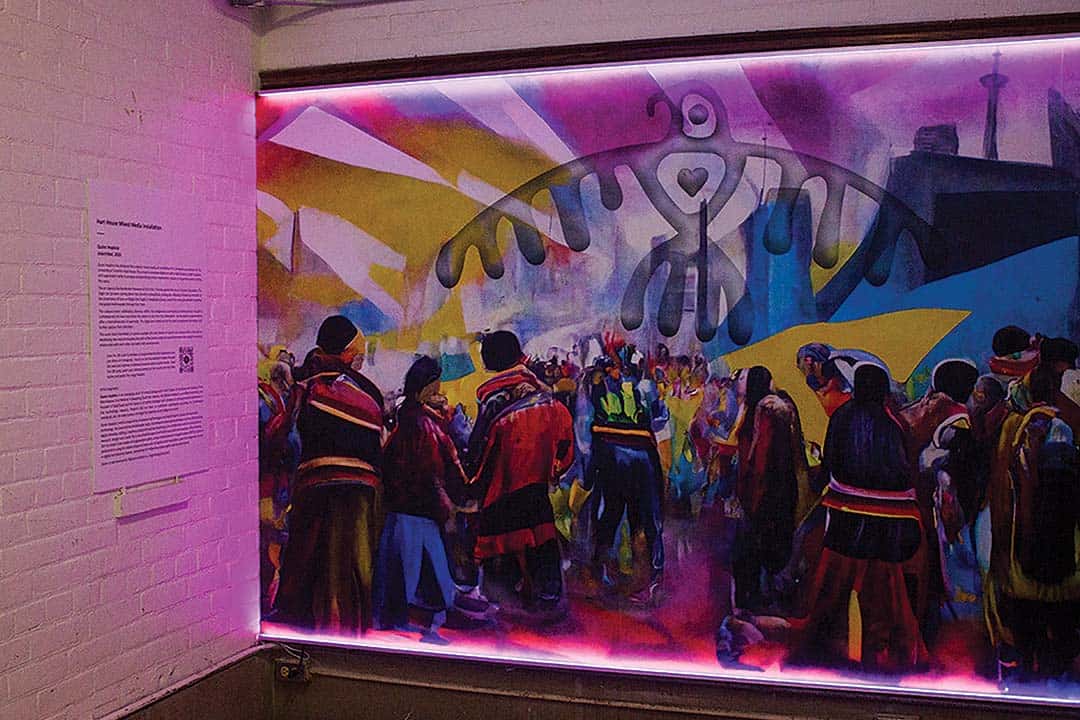Students who have recently stopped by Hart House may have passed a new art installation at the east end of the basement level. The mural, “Intertribal, 2022,” is a mixed-media creation that depicts a celebratory Indigenous powwow, in which community members can be seen dancing in traditional clothes under an eagle — or “Migizi” in Ojibwe — and Toronto landmarks.
Quinn Hopkins, a multidisciplinary artist of Ojibwe and Meiti heritage, created the mural. In an interview with The Varsity, Hopkins explained that he was inspired by his parents’ backgrounds — spiritual and visual elements inspired by his Ojibwe mother, and the futurist style from his tech entrepreneur father. He said this connection between backgrounds has become part of his personality as an “Indigenous futurist.”
“I always like that term, thinking of the next several generations and what the future holds for my people,” said Hopkins.
An invitation for everyone
Hopkins grew up going to powwows, and he always enjoyed seeing the thriving culture through songs, dance, arts, and crafts. After the pandemic put the tradition on pause, the first return of a crowded powwow under the Toronto skyline struck Hopkins with energy and excitement. “It felt like a really powerful image in my head,” he said.
Hopkins explained that “intertribal” is a dance style and an invitation to everyone regardless of their background to simply enjoy being part of the celebration. “You don’t have to be a dancer. You don’t have to have regalia on,” he said. “You can just go into the circle, and they play a song and everyone dances and walks around.”
He described this inclusiveness and sense of sharing a culture with everyone, reflecting the kind of community he would like to create at Hart House. He said the artworks he likes are the ones that people can get excited about, would be able to see themselves in, and would love to share with their loved ones.
At the centre of the mural is an eagle that flies high above the crowd and the city’s skyline. Hopkins said the eagle is a representation of love, and the motion of it soaring toward the sky is a message of linking people to the creator. “So it’s not really just an eagle. It’s love, and it’s kind of like being close to God, close to the creator, and finding yourself in that,” said Hopkins.
Technology and an ever-changing community
What makes the mural stand out is also its technological component. The artwork includes an augmented reality (AR) aspect that can be activated by scanning a QR code that redirects users to Instagram and prompts the audience to point the camera at the mural. Once the step is completed, your screen will show an animated eagle flying out of the mural and circling around the room.
“I always like to have [an]… Easter egg,” said Hopkins. “And [the AR flying eagle] tells another story about love. Love is a very introspective teaching in the admission of a culture. It’s about loving yourself, and then loving those around you like your community. And that was also sort of an aspect of it.”
Hopkins believes technology has been an extraordinary medium of art that expanded his creativity, and also a great tool to break down stereotypes and lead the community toward the future. To him, it is important to show young Indigenous artists like him that there are no limits on what they can do. He said Indigenous culture is not stagnant and has always been innovative, and the use of technology lifts up the community and creates a new category of arts.
“We are not limited to doing woodland paintings,” he said. “We aren’t limited to making totem poles, or all the stereotypical sort of creations that you think of when you think of native art.”


